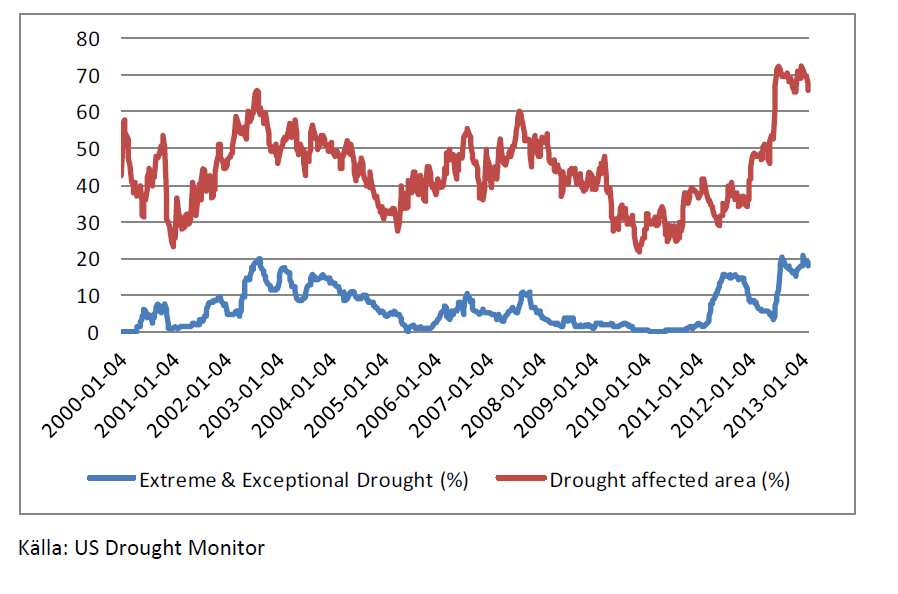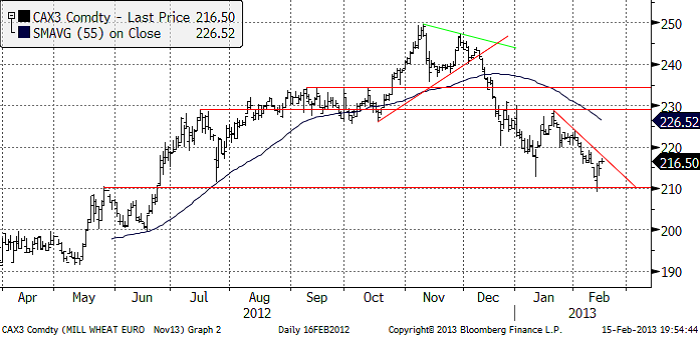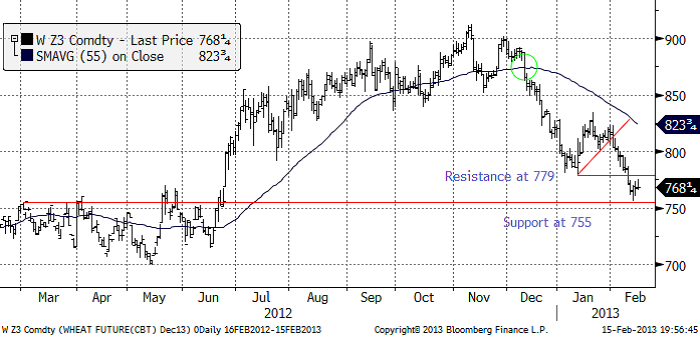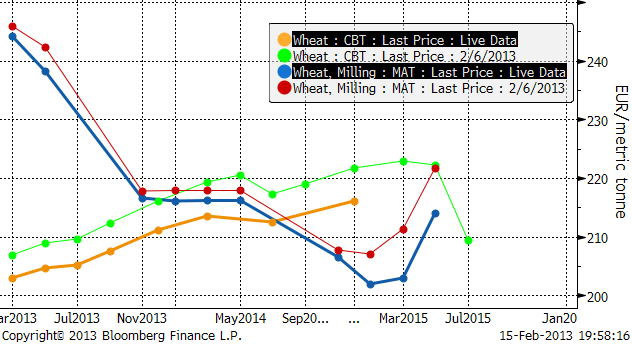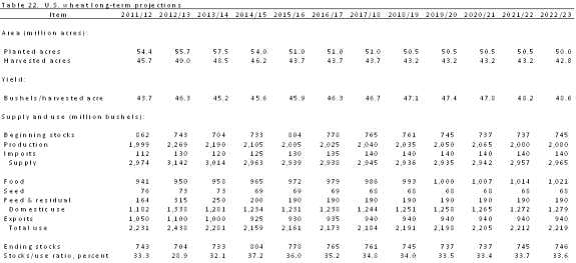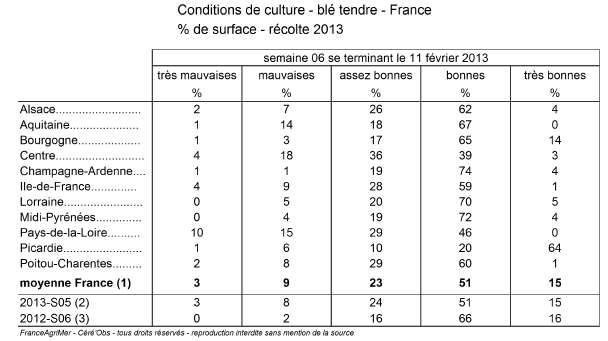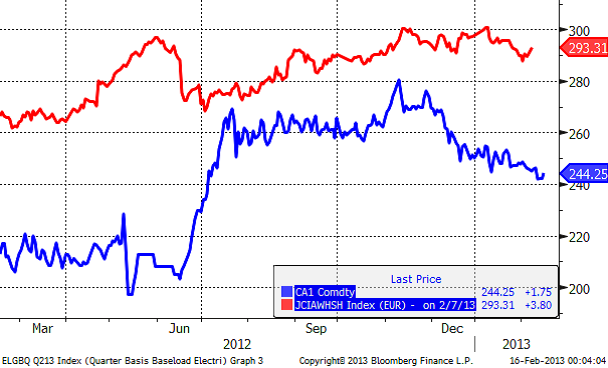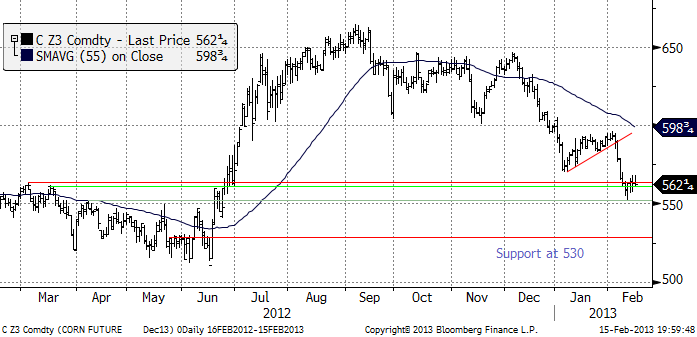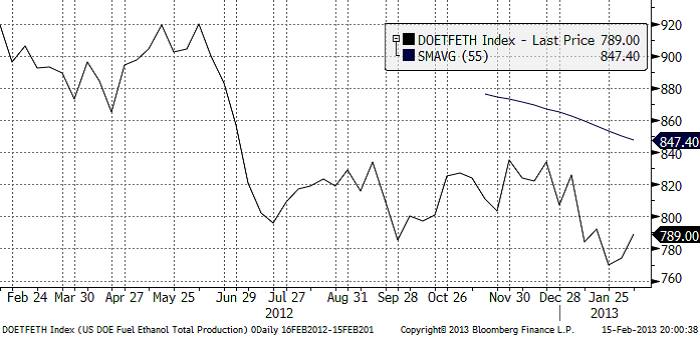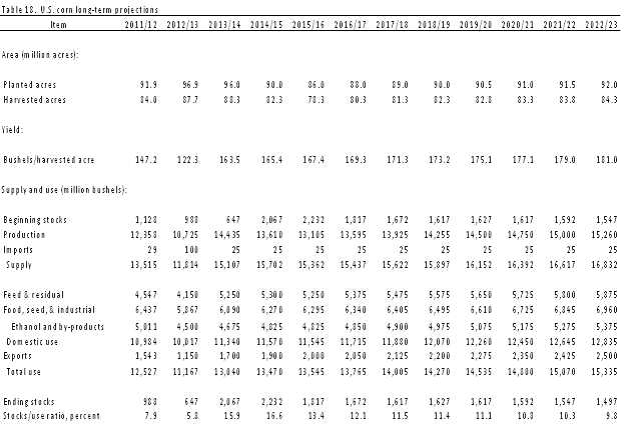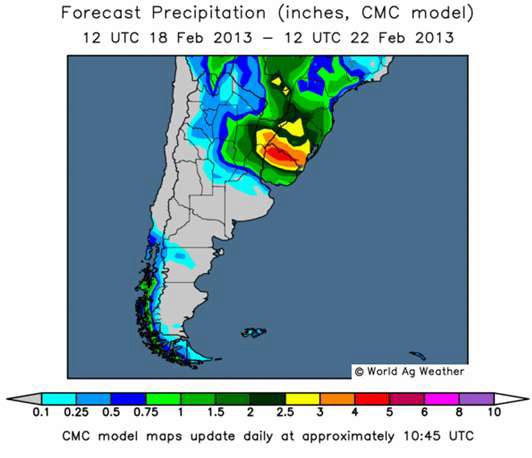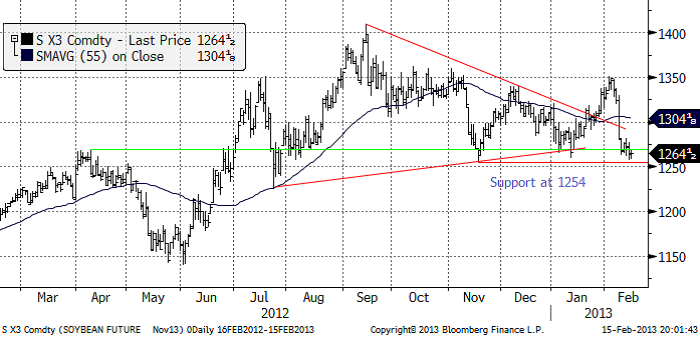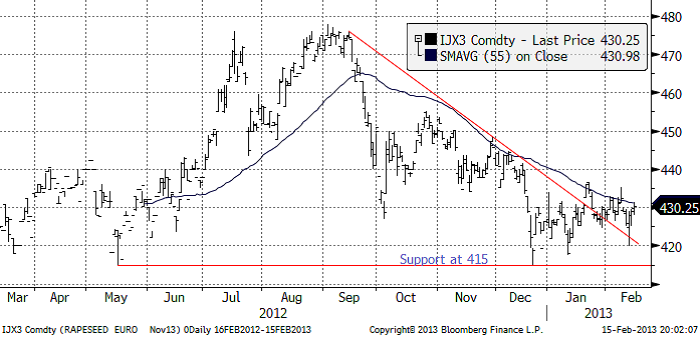Analys
SEB Jordbruksprodukter, 18 februari 2013
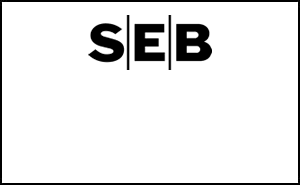
 Det är en något mindre del av USA som är drabbat av torka i den senaste veckans Drought Monitor-rapport, än veckan innan. Frågan är om detta nu är början på mindre torka, bättre utsikter för en god skörd och därmed lägre pris. Det är (nästan) alltid på våren och sommaren som skörden och därmed priset avgörs.
Det är en något mindre del av USA som är drabbat av torka i den senaste veckans Drought Monitor-rapport, än veckan innan. Frågan är om detta nu är början på mindre torka, bättre utsikter för en god skörd och därmed lägre pris. Det är (nästan) alltid på våren och sommaren som skörden och därmed priset avgörs.
Vädret i Brasilien fortsätter att vara bra. Vädret i Argentina ser ut att förbättras. I Ryssland är det blandat. Det finns faktiskt risk för torka. Den som följt med i temperaturen på potentiella semesterorter, har kanske noterat att det är uppåt 30 grader varmt vid Svarta Havskusten.
Vete
Priset på november (2013) kontraktet slutade 1% lägre än förra veckan, efter att ha börjat med ett kraftigt prisfall ner till 210 euro innan rekylen uppåt kom. 210 euro är ett tekniskt stöd. Bryts detta på uppsidan i veckan som kommer, är prisfallet från början av december troligen hejdat för ett tag framöver. Men det mest sannolika är att priset vänder ner igen för ett nytt test av 210-nivån.
Nedan ser vi decemberkontraktet på CBOT, som inte lyckades rekylera upp lika mycket som Matif, efter att ha inlett veckan med prisfall. Det finns en gammal stödnivå på 755, som även fungerade i veckan som gick. Det finns också ett motstånd på 779 cent. Däremellan ligger nu marknaden. Frågan är vilket av stödet eller motståndet som ska brytas. Vi skulle gissa att stödet bryts, baserat på hur kursutvecklingen brukar bli när det är så här. Det finns i så fall potential för priset att falla ner mot 700 cent, eller strax däröver, det vill säga in i det prisintervall som vetet handlade i under förra våren.
Vi ser i diagrammet nedan att Chicago-terminerna fallit över hela linjen. Notera också de konstiga priserna på de allra längsta terminskontrakten.
Det amerikanska jordbruksdepartementet USDA kom ut med sin långtidsprognos nu i veckan som sträcker sig fram till 2022. Prognosen för vete 2013/14 visar en ökning med 3% på årsbasis för sådd areal till 57.5 miljoner acres, vilket är den högsta nivån sedan 2009, men under de kommande åren förväntas sådd areal att fortsätta den historiska nedgången. Skördad areal förväntas hamna på 48.5 miljoner acres, vilket är 3% lägre än under 2012 som en följd av grödornas dåliga tillstånd. Långtidsprognosen innehöll också USDA’s första prognos för 2013 års veteproduktion som förväntas uppgå till 2,190 mb, vilket är en minskning med 79 mb jämfört med 2012, men den största produktionen under prognosperioden fram till 2022. Den genomsnittliga avkastningen 2013 beräknas uppgå till 45.2 bu/acre, och förväntas därefter att öka stadigt under åren för att 2022 uppgå till 48.6 bu/acre. Prognosen för ingående lager av vete per den 1 juni 2014 är satt till 733 mb, jämfört med estimatet för 2013 som ligger på 704 mb. Ingående lager 2015 förväntas uppgå till 804 mb, vilket skulle vara den högsta nivån under hela prognosperioden.
Strategie Grains justerar ned sin prognos för EU’s produktion av vete 2013/14 med 1.1 mt till 132.2 mt, som en följd av det blöta vädret i Storbritannien och lägre areal i Frankrike. SG säger att kontinuerliga regn begränsade sådden av höstvete i Storbritannien medan ny information har lett till en minskad uppskattning av vete arealen i Frankrike. De båda ländernas sammanlagda produktion justeras ned med 1.4 mt jämfört med förra månaden, något som dock uppvägdes något av marginellt högre skördeestimat för Litauen, Tjeckien, Rumänien och Bulgarien.
FranceAgriMer säger att EU:s lantbrukare kan komma att öka skördearealen för vete i år med 3% genom ökad sådd i Polen och Rumänien. Arealen förväntas uppgå till 23.8 miljoner hektar mot förra årets 23 miljoner hektar. Frankrikes vete areal kan komma att öka med 3 procent, medan arealen i Tyskland, Polen och Rumänien förväntas öka med 3%, 10% och 9% respektive. Även i Spanien, Italien och Ungern förväntas vetearealen bli högre i år än förra året. Arealen för vete i Storbritannien förvänts däremot att minska med mer än 200 000 hektar till 1.78 miljoner hektar på grund av att sådden försvårades av det kraftiga regnandet, framförallt i de östra delarna av landet.
Per den 11 februari klassas 66% av vetet i Frankrike som ”good/excellent” enligt FranceAgriMer i en den första rapporten efter vetets vintervila. Den förra rapporten som släpptes den 3 december, före vintervilan, låg på 74% good/excellent. För ett år sedan var 82% i good/excellent skick.
De två största veteodlingsområdena i Frankrike, Centre och Picardie har fått dubbelt så mycket regn under december som normalt. Utsädesföretaget Groupe Limagrain rapporterar att det finns skador på grödan i alla regioner där det regnat för mycket och marken är mättad av fukt. I tabellen nedan ser vi att Centre har en högre andel vete i dåligt skick än alla andra landsdelar.
Utsikterna för Kinas grödor har återigen aktualiserats. Lokala USDA analytiker säger att veteproduktionen 2012/13 beräknas till 108 mt på grund av problem med fusarium i stora veteproducerande regioner såsom Anhui, Hubei, Jiangsu och Henan provinsen. Detta skulle vara betydligt lägre än den officiella siffran på 121 mt. Slutsatsen man kan dra av detta är att Kinas import av vete därmed kan vara mycket högre än tidigare väntat och vi hör från våra kontakter i marknaden att det ryktas om att Kina nyligen har köpt vete från USA och Australien.
Mellan augusti 2012 och januari 2013 steg det lokala vetepriset från 2169 RMB till 2360 RMB per ton, en ökning med 9 procent, vilket enligt FAS skulle kunna vara en stark indikation på att veteproduktionen och det totala tillgängliga utbudet är lägre än de kinesiska officiella produktionsestimaten. Nedan ser vi priset på spotkontraktet på Matif och Ex-warehouse vetepris i Shanghai, också i euro per ton (omräknat).
Vi fortsätter vår neutrala vy på vetet. Tekniskt lutar det åt lägre pris. Det verkar som om marknaden tagit fasta på att torkan i USA visar tecken på att ha toppat ur. Orosmoment som risken för torka i Ryssland och risken för större importbehov i Kina har hittills inte lyckats gripa tag i marknadens aktörer.
Majs
Majspriset (december 2013) nådde 550 cent, vilket var det ”mål” vi nämnde för ett par veckor sedan. Vi tror att den rekyl vi såg mot slutet av veckan är en så teknisk så kallad ”flagga” och att priset kommer att vända ner igen. Nästa stöd finns på 530 cent. Dit tror vi att priset går.
Veckovis etanolproduktion i USA har hämtat sig sedan den 25 januari när den nådde den rekordlåga nivån 770,000 fat / dag.
USDA:s långtidsprognos fram till 2022, visar att sådd majs areal i USA förväntas bli den näst största under 2013 och produktionen förväntas uppgå till rekordhöga 14,435 mb.
I förra veckan kom Buenos Aires Grain Exchange (BAGE) med sin första prognos för Argentinas majsproduktion 2012/13, som förväntas uppgå till rekordhöga 25 mt, vilket är en ökning från förra årets 21.5 mt när torka drabbade grödorna. BAGE:s prognos är dock betydligt lägre än USDA:s. I den senaste WASDE-rapporten angavs väntad skörd enligt USDA till 27 mt. Argentina är världens tredje största exportör av majs och oro över det torra vädret i Argentina har gett stöd åt de internationella priserna pga låga lager efter torkan i USA under förra säsongen. Den senaste veckan har dock landet fått spridda skurar över delar av provinserna Cordoba, Santa Fe och Buenos Aires men mer nederbörd behövs. Svalare temperaturer och en hel del nederbörd förväntas i de norra delarna under kommande vecka, medan torkan förväntas fortsätta i de centrala delarna.
Strategie Grains justerar upp sin prognos för EU:s produktion av majs 2013/14 med 0.9 mt till 63.7 mt, som en följd av införandet av officiella uppskattningar för Tyskland och Ungern i kombination med ett skifte av areal från höstgrödor. Vi fortsätter att ha en neutral (till negativ) vy på majs.
Sojabönor
Sojabönorna (november 2013) fortsatte att röra sig nedåt, efter det stora prisfallet när WASDE-rapporten publicerades. 1254 cent är ett viktigt stöd. Bryts det kan prisfallet bli stort.
Norra Argentina / södra Braslien, som har varit torrt har blivit fuktigare och Mato Grosso, där det nu skördas, har det blivit torrare. Perfeito, tycker de säkert.
Om USA nu verkligen skulle bli mindre torrt, kan priset på sojabönor inleda en trend nedåt. Medan det är väldigt ”tight” för gammal skörd, tycks det kunna bli en mindre ansträngd situation för den nya skörden och det nya marknadsföringsåret.
Raps
Rapspriset (november 2013) har fortsatt att röra sig ”sidledes” med ganska tvära kast. Det verkar finnas fyndköpare på 420 euro per ton. Det verkar också finnas en hel del spridda säljintressen kring 430 euro.
ABARE höjde den australiensiska canola-skörden till 3.1 mt (från 2.6 mt).
Vi fortsätter att ha en övervägande negativ vy på prisutvecklingen på raps.
[box]SEB Veckobrev Jordbruksprodukter är producerat av SEB Merchant Banking och publiceras i samarbete och med tillstånd på Råvarumarknaden.se[/box]
Disclaimer
The information in this document has been compiled by SEB Merchant Banking, a division within Skandinaviska Enskilda Banken AB (publ) (“SEB”).
Opinions contained in this report represent the bank’s present opinion only and are subject to change without notice. All information contained in this report has been compiled in good faith from sources believed to be reliable. However, no representation or warranty, expressed or implied, is made with respect to the completeness or accuracy of its contents and the information is not to be relied upon as authoritative. Anyone considering taking actions based upon the content of this document is urged to base his or her investment decisions upon such investigations as he or she deems necessary. This document is being provided as information only, and no specific actions are being solicited as a result of it; to the extent permitted by law, no liability whatsoever is accepted for any direct or consequential loss arising from use of this document or its contents.
About SEB
SEB is a public company incorporated in Stockholm, Sweden, with limited liability. It is a participant at major Nordic and other European Regulated Markets and Multilateral Trading Facilities (as well as some non-European equivalent markets) for trading in financial instruments, such as markets operated by NASDAQ OMX, NYSE Euronext, London Stock Exchange, Deutsche Börse, Swiss Exchanges, Turquoise and Chi-X. SEB is authorized and regulated by Finansinspektionen in Sweden; it is authorized and subject to limited regulation by the Financial Services Authority for the conduct of designated investment business in the UK, and is subject to the provisions of relevant regulators in all other jurisdictions where SEB conducts operations. SEB Merchant Banking. All rights reserved.
Analys
Tightening fundamentals – bullish inventories from DOE

The latest weekly report from the US DOE showed a substantial drawdown across key petroleum categories, adding more upside potential to the fundamental picture.

Commercial crude inventories (excl. SPR) fell by 5.8 million barrels, bringing total inventories down to 415.1 million barrels. Now sitting 11% below the five-year seasonal norm and placed in the lowest 2015-2022 range (see picture below).
Product inventories also tightened further last week. Gasoline inventories declined by 2.1 million barrels, with reductions seen in both finished gasoline and blending components. Current gasoline levels are about 3% below the five-year average for this time of year.
Among products, the most notable move came in diesel, where inventories dropped by almost 4.1 million barrels, deepening the deficit to around 20% below seasonal norms – continuing to underscore the persistent supply tightness in diesel markets.
The only area of inventory growth was in propane/propylene, which posted a significant 5.1-million-barrel build and now stands 9% above the five-year average.
Total commercial petroleum inventories (crude plus refined products) declined by 4.2 million barrels on the week, reinforcing the overall tightening of US crude and products.
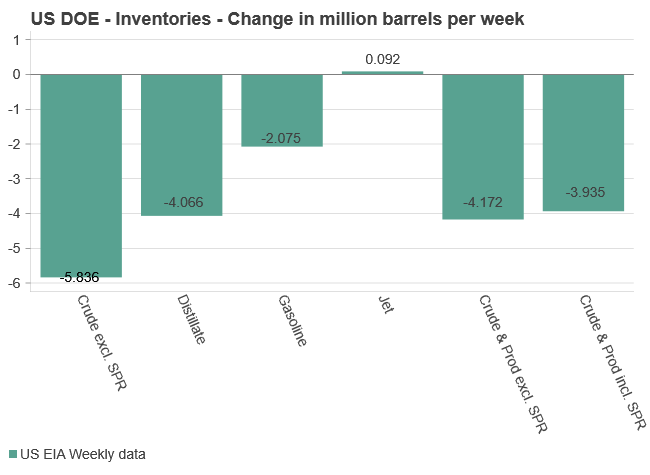

Analys
Bombs to ”ceasefire” in hours – Brent below $70

A classic case of “buy the rumor, sell the news” played out in oil markets, as Brent crude has dropped sharply – down nearly USD 10 per barrel since yesterday evening – following Iran’s retaliatory strike on a U.S. air base in Qatar. The immediate reaction was: “That was it?” The strike followed a carefully calibrated, non-escalatory playbook, avoiding direct threats to energy infrastructure or disruption of shipping through the Strait of Hormuz – thus calming worst-case fears.

After Monday morning’s sharp spike to USD 81.4 per barrel, triggered by the U.S. bombing of Iranian nuclear facilities, oil prices drifted sideways in anticipation of a potential Iranian response. That response came with advance warning and caused limited physical damage. Early this morning, both the U.S. President and Iranian state media announced a ceasefire, effectively placing a lid on the immediate conflict risk – at least for now.
As a result, Brent crude has now fallen by a total of USD 12 from Monday’s peak, currently trading around USD 69 per barrel.
Looking beyond geopolitics, the market will now shift its focus to the upcoming OPEC+ meeting in early July. Saudi Arabia’s decision to increase output earlier this year – despite falling prices – has drawn renewed attention considering recent developments. Some suggest this was a response to U.S. pressure to offset potential Iranian supply losses.
However, consensus is that the move was driven more by internal OPEC+ dynamics. After years of curbing production to support prices, Riyadh had grown frustrated with quota-busting by several members (notably Kazakhstan). With Saudi Arabia cutting up to 2 million barrels per day – roughly 2% of global supply – returns were diminishing, and the risk of losing market share was rising. The production increase is widely seen as an effort to reassert leadership and restore discipline within the group.
That said, the FT recently stated that, the Saudis remain wary of past missteps. In 2018, Riyadh ramped up output at Trump’s request ahead of Iran sanctions, only to see prices collapse when the U.S. granted broad waivers – triggering oversupply. Officials have reportedly made it clear they don’t intend to repeat that mistake.
The recent visit by President Trump to Saudi Arabia, which included agreements on AI, defense, and nuclear cooperation, suggests a broader strategic alignment. This has fueled speculation about a quiet “pump-for-politics” deal behind recent production moves.
Looking ahead, oil prices have now retraced the entire rally sparked by the June 13 Israel–Iran escalation. This retreat provides more political and policy space for both the U.S. and Saudi Arabia. Specifically, it makes it easier for Riyadh to scale back its three recent production hikes of 411,000 barrels each, potentially returning to more moderate increases of 137,000 barrels for August and September.
In short: with no major loss of Iranian supply to the market, OPEC+ – led by Saudi Arabia – no longer needs to compensate for a disruption that hasn’t materialized, especially not to please the U.S. at the cost of its own market strategy. As the Saudis themselves have signaled, they are unlikely to repeat previous mistakes.
Conclusion: With Brent now in the high USD 60s, buying oil looks fundamentally justified. The geopolitical premium has deflated, but tensions between Israel and Iran remain unresolved – and the risk of missteps and renewed escalation still lingers. In fact, even this morning, reports have emerged of renewed missile fire despite the declared “truce.” The path forward may be calmer – but it is far from stable.
Analys
A muted price reaction. Market looks relaxed, but it is still on edge waiting for what Iran will do

Brent crossed the 80-line this morning but quickly fell back assigning limited probability for Iran choosing to close the Strait of Hormuz. Brent traded in a range of USD 70.56 – 79.04/b last week as the market fluctuated between ”Iran wants a deal” and ”US is about to attack Iran”. At the end of the week though, Donald Trump managed to convince markets (and probably also Iran) that he would make a decision within two weeks. I.e. no imminent attack. Previously when when he has talked about ”making a decision within two weeks” he has often ended up doing nothing in the end. The oil market relaxed as a result and the week ended at USD 77.01/b which is just USD 6/b above the year to date average of USD 71/b.

Brent jumped to USD 81.4/b this morning, the highest since mid-January, but then quickly fell back to a current price of USD 78.2/b which is only up 1.5% versus the close on Friday. As such the market is pricing a fairly low probability that Iran will actually close the Strait of Hormuz. Probably because it will hurt Iranian oil exports as well as the global oil market.
It was however all smoke and mirrors. Deception. The US attacked Iran on Saturday. The attack involved 125 warplanes, submarines and surface warships and 14 bunker buster bombs were dropped on Iranian nuclear sites including Fordow, Natanz and Isfahan. In response the Iranian Parliament voted in support of closing the Strait of Hormuz where some 17 mb of crude and products is transported to the global market every day plus significant volumes of LNG. This is however merely an advise to the Supreme leader Ayatollah Ali Khamenei and the Supreme National Security Council which sits with the final and actual decision.
No supply of oil is lost yet. It is about the risk of Iran closing the Strait of Hormuz or not. So far not a single drop of oil supply has been lost to the global market. The price at the moment is all about the assessed risk of loss of supply. Will Iran choose to choke of the Strait of Hormuz or not? That is the big question. It would be painful for US consumers, for Donald Trump’s voter base, for the global economy but also for Iran and its population which relies on oil exports and income from selling oil out of that Strait as well. As such it is not a no-brainer choice for Iran to close the Strait for oil exports. And looking at the il price this morning it is clear that the oil market doesn’t assign a very high probability of it happening. It is however probably well within the capability of Iran to close the Strait off with rockets, mines, air-drones and possibly sea-drones. Just look at how Ukraine has been able to control and damage the Russian Black Sea fleet.
What to do about the highly enriched uranium which has gone missing? While the US and Israel can celebrate their destruction of Iranian nuclear facilities they are also scratching their heads over what to do with the lost Iranian nuclear material. Iran had 408 kg of highly enriched uranium (IAEA). Almost weapons grade. Enough for some 10 nuclear warheads. It seems to have been transported out of Fordow before the attack this weekend.
The market is still on edge. USD 80-something/b seems sensible while we wait. The oil market reaction to this weekend’s events is very muted so far. The market is still on edge awaiting what Iran will do. Because Iran will do something. But what and when? An oil price of 80-something seems like a sensible level until something do happen.
-

 Nyheter4 veckor sedan
Nyheter4 veckor sedanStor uppsida i Lappland Guldprospekterings aktie enligt analys
-

 Nyheter4 veckor sedan
Nyheter4 veckor sedanSilverpriset släpar efter guldets utveckling, har mer uppsida
-

 Nyheter3 veckor sedan
Nyheter3 veckor sedanUppgången i oljepriset planade ut under helgen
-

 Nyheter2 veckor sedan
Nyheter2 veckor sedanMahvie Minerals växlar spår – satsar fullt ut på guld
-

 Nyheter3 veckor sedan
Nyheter3 veckor sedanLåga elpriser i sommar – men mellersta Sverige får en ökning
-

 Analys3 veckor sedan
Analys3 veckor sedanVery relaxed at USD 75/b. Risk barometer will likely fluctuate to higher levels with Brent into the 80ies or higher coming 2-3 weeks
-

 Nyheter2 veckor sedan
Nyheter2 veckor sedanOljan, guldet och marknadens oroande tystnad
-

 Nyheter2 veckor sedan
Nyheter2 veckor sedanJonas Lindvall är tillbaka med ett nytt oljebolag, Perthro, som ska börsnoteras


